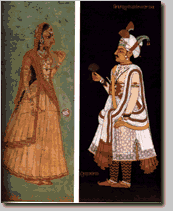
Adorning The Self

We know about fashion in ancient India only from looking at sculpture as very few examples of costumes, textiles and jewellery have survived. In the Indus Valley Civilisation (c. 3000-1500 BC), clothing tended to be simple. Mem wore loin-cloths while women were bare to the waist. Status was reflected in the kind of jewellery wom; high ranking women sometimes covered their bosoms with jewels. It was only with the coming of the Aryans to India that more complicated clothing was worn. This consisted of two parts: the upper and lower garments. Later, a cloak was added. These were generally pieces of cloth draped over the body in a style seen in many Indian costumes today.
With the coming of the Muslims, there was a shift towards covering the body as evidenced in the purdah. Following the Muslims, Hindu wonmen began to adopt the choli (bodice) to cover their bare-chests. The emperors Jaharlgr (1605-1627) and Shah Jahan (11627-1658) amassed great fortunes which they used to spend on beautiful objects including jewellery. From the A'in-i Akbari, we know that there were designers from Europe and the Middle East Jahangir at the Mughal court during Akbar's reign.
Certain kinds of adornmrnt conveyed specific meanings, such as the turban. When in audience with the king, it was mandatory to cover the head as it was a sign of honour. While the rich indulged themselves with fine clothes and jewels, the peasant wore only the most functional clothing, leaving most of his body bare. However, lack of wealth and status was not the only reason for choosing simple clothing. Individuals such as the sadhu (ascetic) wore the most simple clothing in keeping with his spiritual aim of denying the ego and forsaking the material pleasures of the world.
Many ancient costumes and jewellery styles have survived to this day with only slight modifications. There are also regional variations in some costumes, such as the sari. In spite of these changes in sty]es which have taken place in tandem with changes in Indian society, the trend towards simplicity or opulence continues to be a major influence in costume and jewellery.
 Alamkara Home Page : Table of Content
Alamkara Home Page : Table of Content